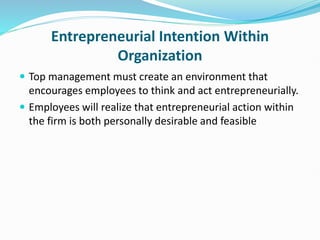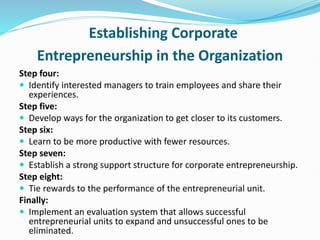Lecture 2.pptx
- 2. The Intention to Act Entrepreneurially Entrepreneurial intentions: Motivational factors that influence individuals to pursue entrepreneurial outcomes. Intention is stronger when an action is perceived to be feasible and desirable. Entrepreneurial self-efficacy: Conviction that one can successfully execute the entrepreneurial process. Perceived desirability: The degree to which an individual has a favorable or unfavorable evaluation of the potential outcomes.
- 3. Entrepreneur Background and Characteristics Education: Provides a background about starting a business. Helps in the development of communication skills and problem- solving skills. Provides individuals with a larger opportunity set. Does not determine whether an entrepreneur will create a new business to exploit the discovered opportunity. Age: Most entrepreneurs initiate their entrepreneurial careers between the ages of 22 and 45. Individuals are more inclined to start an career at milestone ages every five years (25, 30, 35, 40, and 45). Male entrepreneurs tend to start their ventures in their early 30s, while women entrepreneurs do so in their middle 30s.
- 4. Entrepreneurial Intention Within Organization Top management must create an environment that encourages employees to think and act entrepreneurially. Employees will realize that entrepreneurial action within the firm is both personally desirable and feasible
- 5. Establishing Corporate Entrepreneurship in the Organization Step one: Secure a commitment to corporate entrepreneurship in the organization by top, upper, and middle management levels. Establish initial framework and embrace the concept. Identify, select, and train corporate entrepreneurs. Step two: Identify ideas and areas that top management is interested in supporting. Identify amount of risk money available to develop the concept. Establish overall program expectations and target results of each corporate venture. Establish mentor/sponsor system. Step three: Use of technology to ensure organizational flexibility.
- 6. Establishing Corporate Entrepreneurship in the Organization Step four: Identify interested managers to train employees and share their experiences. Step five: Develop ways for the organization to get closer to its customers. Step six: Learn to be more productive with fewer resources. Step seven: Establish a strong support structure for corporate entrepreneurship. Step eight: Tie rewards to the performance of the entrepreneurial unit. Finally: Implement an evaluation system that allows successful entrepreneurial units to expand and unsuccessful ones to be eliminated.
- 7. Establishing Corporate Entrepreneurship in the Organization Problems and Successful Efforts: A study found that new ventures started within a corporation performed worse than those started independently by entrepreneurs. Reasons cited: Corporation’s difficulty in maintaining a long-term commitment. A lack of freedom to make autonomous decisions. A constrained environment. On average, independent start-ups become: Profitable twice as fast. End up twice as profitable.
- 8. Companies that have adopted their own version of the implementation process to launch new ventures successfully: Minnesota Mining and Manufacturing (3M). Hewlett-Packard (HP). IBM.
- 9. END








